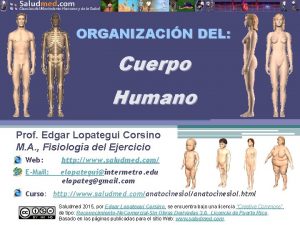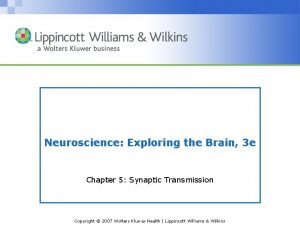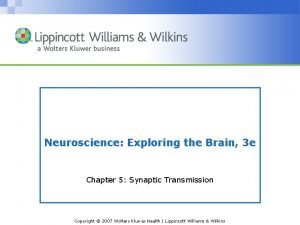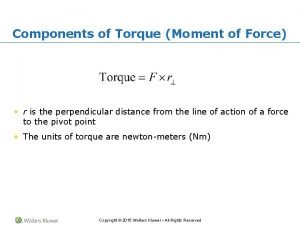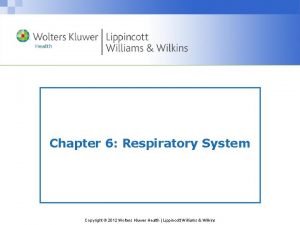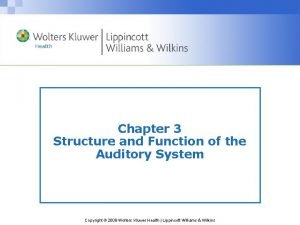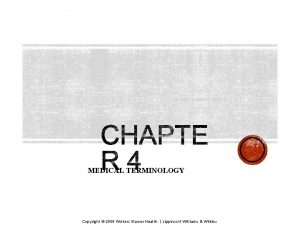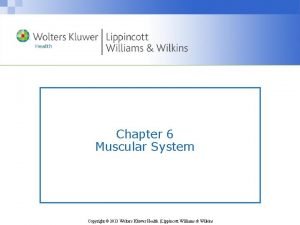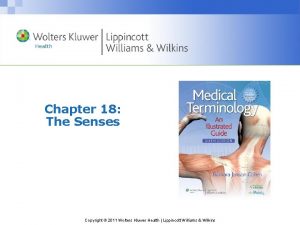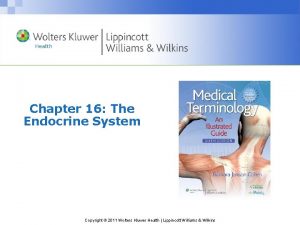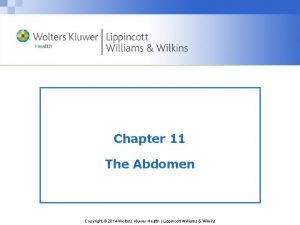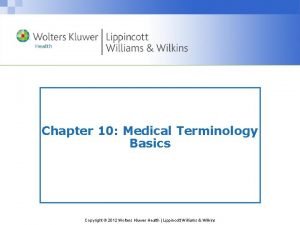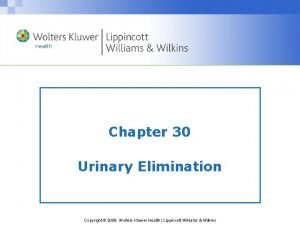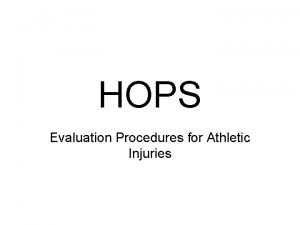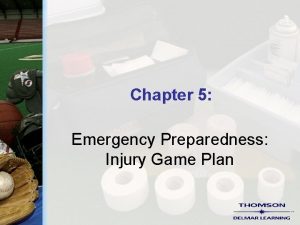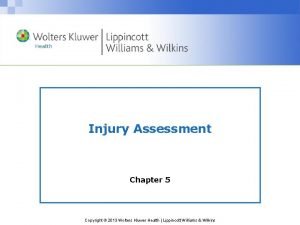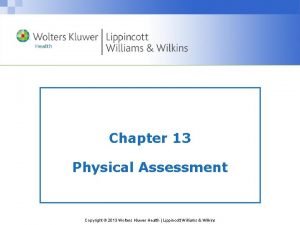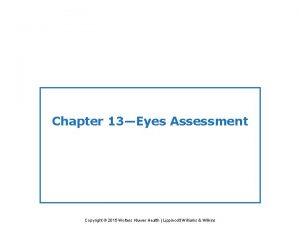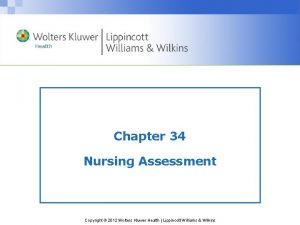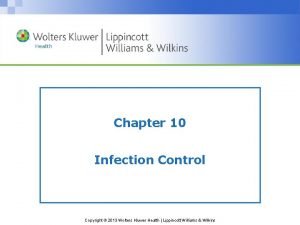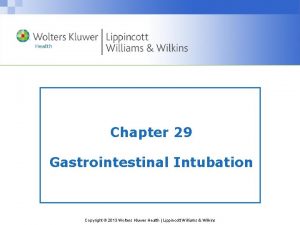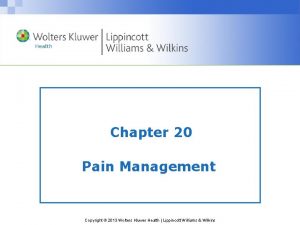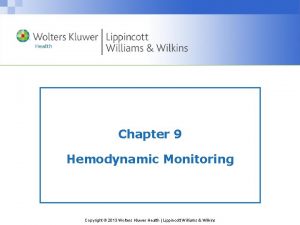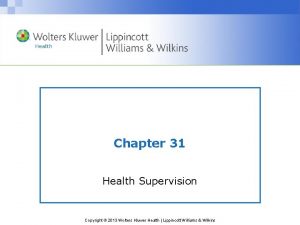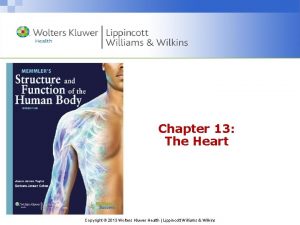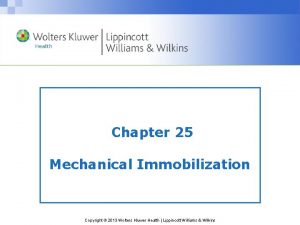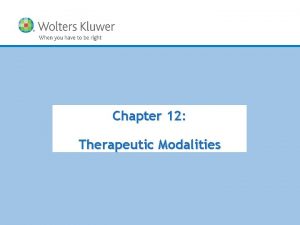Injury Assessment Chapter 5 Copyright 2013 Wolters Kluwer











































- Slides: 43

Injury Assessment Chapter 5 Copyright © 2013 Wolters Kluwer Health | Lippincott Williams & Wilkins

Injury Evaluation Process • Symptom – Information provided by the injured person regarding their perception of the problem • Sign – Objective, measurable physical finding Copyright © 2013 Wolters Kluwer Health | Lippincott Williams & Wilkins

Injury Evaluation Process (cont. ) • Establish a reference point by assessing the opposite, noninjured body part • Methods – HOPS • Subjective – history • Objective – observation, palpation, special tests – SOAP • Subjective and objective – same as HOPS • Additional – assessment and planning • Common abbreviations - refer to Table 5. 1 Copyright © 2013 Wolters Kluwer Health | Lippincott Williams & Wilkins

Injury Evaluation Process (cont. ) • Assessment – suspected site of injury, involved structures, and severity of injury – Establish long and short term goals • Plan – therapeutic modalities and exercises, educational consultations, and functional activities – Actionplan for achieving goals Copyright © 2013 Wolters Kluwer Health | Lippincott Williams & Wilkins

Injury Evaluation Process (cont. ) • All clinicians have an ethical responsibility to keep accurate and factual records • Injury Assessment Protocol – refer to Application Strategy 5. 1 Copyright © 2013 Wolters Kluwer Health | Lippincott Williams & Wilkins

History of Injury • Can be most important step in assessment • Involves not only asking questions, but establishing a professional and comfortable atmosphere • Information provided is subjective, but should be gathered and recorded as quantitatively as possible • Document history in writing • Includes: – Primary complaint – Mechanism of injury – Characteristics of symptoms – Related medical history Copyright © 2013 Wolters Kluwer Health | Lippincott Williams & Wilkins

History of Injury (cont. ) • Primary complaint – What the individual believes is the current injury – Questions • Mechanism of injury – Attempt to visualize injury to identify possible injured structures – Questions Copyright © 2013 Wolters Kluwer Health | Lippincott Williams & Wilkins

History of Injury (cont. ) • Characteristics of symptoms – Location, onset, severity, frequency, duration, limitations due to pain – Questions – Pain • Somatic • Deep • Diffuse or nagging; with possible stabbing pain; longer lasting • Injury to bone, internal joint structures, or muscles • Superficial • Sharp, prickly; brief duration • Injury to skin • Visceral • Deep, nagging, and pressing; often accompanied by nausea and vomiting • Injury to internal organ • Referred pain Copyright © 2013 Wolters Kluwer Health | Lippincott Williams & Wilkins

History of Injury (cont. ) • Visceral organs can refer pain to specific cutaneous areas Copyright © 2013 Wolters Kluwer Health | Lippincott Williams & Wilkins

History of Injury (cont. ) • Disability resulting from injury – Determine limitations due to pain, weakness, or disability – Questions • Related medical history – Information regarding other problems/conditions potentially affecting this injury – Use of preseason physical exam Copyright © 2013 Wolters Kluwer Health | Lippincott Williams & Wilkins

Observation and Inspection • Observation – Assess state of consciousness and body language that may indicate pain, disability, or other conditions – Note posture, willingness/ability to move, overall attitude – Symmetry and appearance • Congenital and functional problems • Gait – Motor function • Assess general motor function • Rule out injury to other joints Copyright © 2013 Wolters Kluwer Health | Lippincott Williams & Wilkins

Observation and Inspection (cont. ) • Inspection – Factors seen at the actual injury site (e. g. , deformity, discoloration, swelling, signs of infection, scars) Copyright © 2013 Wolters Kluwer Health | Lippincott Williams & Wilkins

Palpation • Prior to contact, permission must be granted to the AT to touch the patient • Bilateral palpation – Temperature – Swelling – Point tenderness – Crepitus – Deformity – Muscle spasm – Cutaneous sensation – Pulse • Gentle, circular pressure followed by gradual, deeper pressure • Begin away from injured site and move toward injury Copyright © 2013 Wolters Kluwer Health | Lippincott Williams & Wilkins

Palpation (cont. ) • Determining a possible fracture Copyright © 2013 Wolters Kluwer Health | Lippincott Williams & Wilkins

Physical Examination Tests • Functional testing – Objectively measure using goniometer – Age and gender may influence ROM – AROM • Joint motion performed voluntarily by the individual through muscular contraction • Perform before PROM • Indicates willingness and ability to move body part • Determines possible damage to contractile tissue; measures muscle strength and movement coordination • Measurement of all motions, except rotation, starts with the body in anatomic position Copyright © 2013 Wolters Kluwer Health | Lippincott Williams & Wilkins

Physical Examination Tests (cont. ) – PROM • The injured body part is moved through ROM with no assistance from the injured individual • Distinguishes injury to contractile tissues from noncontractile or inert tissues • End of the range, gentle overpressure to determine end feel • Differences in ROM between AROM and PROM • Accessory movements § Loose-packed position § Close-packed position Copyright © 2013 Wolters Kluwer Health | Lippincott Williams & Wilkins

Physical Examination Tests (cont. ) – RROM • Can assess muscle strength and detect injury to the nervous system • Break test or entire ROM Copyright © 2013 Wolters Kluwer Health | Lippincott Williams & Wilkins

Physical Examination Tests (cont. ) • Ligamentous and capsular testing – Assess joint function and integrity of joint structures – Laxity vs. instability – Test at proper angle Copyright © 2013 Wolters Kluwer Health | Lippincott Williams & Wilkins

Physical Examination Tests (cont. ) • Neurologic testing – Nerve root • Somatic • Visceral – CNS: assess using dermatomes, myotomes, and reflexes • Dermatome – area of skin supplied by a single nerve root • Assess sensation • Abnormal: hypoesthesia, hyperesthesia, paresthesia Copyright © 2013 Wolters Kluwer Health | Lippincott Williams & Wilkins

Physical Examination Tests (cont. ) • The cutaneous sensation patterns of the spinal nerves’ dermatomes differ from the patterns innervated by the peripheral nerves. Copyright © 2013 Wolters Kluwer Health | Lippincott Williams & Wilkins

Physical Examination Tests (cont. ) Copyright © 2013 Wolters Kluwer Health | Lippincott Williams & Wilkins

Physical Examination Tests (cont. ) • Neurologic testing (cont. ) – myotome – group of muscles primarily innervated by a single nerve root • Assess muscle contraction (hold at least 5 seconds) • Abnormal: paresis, paralysis Copyright © 2013 Wolters Kluwer Health | Lippincott Williams & Wilkins

Physical Examination Tests (cont. ) • Neurologic testing (cont. ) – Reflexes • DTRs § Abnormal: diminished, exaggerated or distorted, absent • Superficial reflexes • Pathologic Copyright © 2013 Wolters Kluwer Health | Lippincott Williams & Wilkins

Physical Examination Tests (cont. ) • Peripheral nerve testing – Manual muscle testing – Cutaneous sensation testing – Special compression tests • Activity-specific functional testing – Typical, active movements performed during activity participation – Movements should assess: strength, agility, flexibility, joint stability, endurance, coordination, balance, and sport-specific skill performance Copyright © 2013 Wolters Kluwer Health | Lippincott Williams & Wilkins

Emergency Medical Services System • Process that activates the emergency health care services of the athletic training facility and community to provide immediate health care to an injured individual • The team physician, athletic trainer, and coach have a legal duty to develop and implement an emergency plan to provide health care for participants Copyright © 2013 Wolters Kluwer Health | Lippincott Williams & Wilkins

Emergency Medical Services System (cont. ) • Preseason preparation – Meet with representatives from local EMS agencies to discuss, develop, and evaluate plan – Written plan for each activity site – Practice the emergency plan • Responsibilities of medical personnel – Team physician • Prior to season, delineate responsibilities of all personnel • On-the-field – Athletic trainer • Event set-up • Home vs. away • Presence or absence of physician Copyright © 2013 Wolters Kluwer Health | Lippincott Williams & Wilkins

Emergency Injury Assessment • Primary survey – Determines level of responsiveness – Identifies immediate life-threatening situations (ABCs) – Dictates necessary actions • Triage – Rapid assessment of all injured individuals followed by return to the most seriously injured for treatment – Charge person vs. call person • “Red flags” • On-site assessment; ascertain presence of serious or moderate injury Copyright © 2013 Wolters Kluwer Health | Lippincott Williams & Wilkins

Emergency Injury Assessment (cont. ) • On-site history – Obtained from the individual or bystanders who witnessed the injury – Relatively brief as compared to a comprehensive clinical evaluation – Critical areas (refer to Field Strategy 5. 4) • Location of pain • Presence of abnormal neurologic signs • Mechanism of injury • Associated sounds • History of the injury Copyright © 2013 Wolters Kluwer Health | Lippincott Williams & Wilkins

Emergency Injury Assessment (cont. ) • On-site observation and inspection – Begin en route to individual – Critical areas • Surrounding area • Body position • Movement of the athlete • Level of responsiveness • Primary survey • Inspection for head trauma • Inspection of injured body part Copyright © 2013 Wolters Kluwer Health | Lippincott Williams & Wilkins

Emergency Injury Assessment (cont. ) • Body posturing Copyright © 2013 Wolters Kluwer Health | Lippincott Williams & Wilkins

Emergency Injury Assessment (cont. ) • On-site palpation – General head-to-toe assessment – Determine • Abnormal joint angulation • Bony palpation • Soft tissue palpation • Skin temperature Copyright © 2013 Wolters Kluwer Health | Lippincott Williams & Wilkins

Emergency Injury Assessment (cont. ) • On-site functional testing – When not contraindicated, the individual’s willingness to move the injured body part – AROM, PROM, RROM – Weight bearing • On-site stress testing – Performed prior to any muscle guarding or swelling to prevent obscuring the extent of injury Copyright © 2013 Wolters Kluwer Health | Lippincott Williams & Wilkins

Emergency Injury Assessment (Cont’d) • On-site neurologic testing – Critical to prevent a catastrophic injury – Areas • Cutaneous sensation • Motor function • Vital signs – Pulse • Variety of factors influence pulse • Count carotid for 30 seconds (and double it) • Normal ranges • Adults: 60 -100 • Children: 120 -140 Copyright © 2013 Wolters Kluwer Health | Lippincott Williams & Wilkins

Emergency Injury Assessment (cont. ) – Respiratory rate • Varies with gender and age • Count for 30 seconds (and double it) • Normal ranges § Adults: 10 -25 § Children: 20 -25 – Blood pressure • Pressure or tension of the blood within the systemic arteries • Changes in BP are very significant – Temperature • Normal = 98. 6°F, but can fluctuate considerably • Methods Copyright © 2013 Wolters Kluwer Health | Lippincott Williams & Wilkins

Emergency Injury Assessment (cont. ) – Skin color • Can indicate abnormal blood flow and low blood oxygen concentration in a particular body part • Lightly pigmented individuals § Red, white, and blue § Dark-skinned individuals § Skin pigments mask cyanosis – Pupils • Sensitive to situations affecting the CNS • Pupillary light reflex • Eye movement • Tracking ability • Depth perception – Disposition • Can the situation be handled on-site, or should the individual be referred to a physician? Copyright © 2013 Wolters Kluwer Health | Lippincott Williams & Wilkins

Emergency Injury Assessment (Cont’d) • Equipment considerations – Removal of any athletic helmet should be avoided unless individual circumstances dictate otherwise – Face mask removal • Should be removed prior to transportation, regardless of the current respiratory status – Helmet removal • Requires two trained individuals – Shoulder pad removal • Should not be removed unless life is in danger, and the threat outweighs the risk of a possible spinal cord injury from moving the athlete Copyright © 2013 Wolters Kluwer Health | Lippincott Williams & Wilkins

Moving the Injured Participant • Ambulatory assistance – Aid an injured individual able to walk • Manual conveyance – Individual unable to walk or distance is too great to walk • Transport by spine board – Safest method Copyright © 2013 Wolters Kluwer Health | Lippincott Williams & Wilkins

Diagnostic Testing • The team physician or medical specialist orders tests and interprets the results • The athletic trainer should have a basic understanding of the purpose of the tests Copyright © 2013 Wolters Kluwer Health | Lippincott Williams & Wilkins

Diagnostic Testing (cont. ) • Laboratory tests – Blood test, urinalysis • Radiographs (x-rays) – Can rule out fractures, infections, and neoplasms – Use of radio-opaque dyes • Myelogram • Arthrogram Copyright © 2013 Wolters Kluwer Health | Lippincott Williams & Wilkins

Diagnostic Testing (cont. ) • Computed tomography (CT) scan – Can reveal abnormalities in bone, fat, and soft tissue – Can detect tendon & ligament injuries in varying joint positions Copyright © 2013 Wolters Kluwer Health | Lippincott Williams & Wilkins

Diagnostic Testing (cont. ) • Magnetic resonance imaging (MRI) – Can reveal soft tissue differentiation – Can demonstrate spaceoccupying lesions in the brain – Can demonstrate joint damage – Can view blood vessels and blood flow without use of a contrast medium Copyright © 2013 Wolters Kluwer Health | Lippincott Williams & Wilkins

Diagnostic Testing (cont. ) • Radionuclide scintigraph (bone scan) – Can detect stress fractures of the long bones and vertebrae, degenerative diseases, infections, or tumors of the bone Copyright © 2013 Wolters Kluwer Health | Lippincott Williams & Wilkins

Diagnostic Testing (cont. ) • Ultrasonic imaging – Used to view tendon and other soft tissue imaging • Electromyography – Used to detect denervated muscles, nerve root compression injuries, and other muscle diseases Copyright © 2013 Wolters Kluwer Health | Lippincott Williams & Wilkins
 Wolters kluwer health
Wolters kluwer health Wolters kluwer health
Wolters kluwer health Edgar lopategui corsino
Edgar lopategui corsino Wolters kluwer
Wolters kluwer Shunting inhibition
Shunting inhibition Chemical synapse
Chemical synapse Lippincott williams & wilkins
Lippincott williams & wilkins Wolters kluwer
Wolters kluwer Wolters kluwer
Wolters kluwer Wolters kluwer
Wolters kluwer Wolters kluwer
Wolters kluwer Wolters kluwer
Wolters kluwer Wolters kluwer health
Wolters kluwer health Wolters kluwer
Wolters kluwer Virchow's triad
Virchow's triad Wolters kluwer pronunciation
Wolters kluwer pronunciation Wolters kluwer
Wolters kluwer Copyright
Copyright Wolters kluwer
Wolters kluwer Wolters kluwer
Wolters kluwer Wolters kluwer
Wolters kluwer Wolters kluwer ovid
Wolters kluwer ovid Wolters kluwer health lippincott williams & wilkins
Wolters kluwer health lippincott williams & wilkins Wolters kluwer culture
Wolters kluwer culture Wolters kluwer pronunciation
Wolters kluwer pronunciation Intentional and unintentional injury
Intentional and unintentional injury Mbti personal impact report
Mbti personal impact report Kluwer
Kluwer Hotel merken
Hotel merken What is hops used for in sports medicine
What is hops used for in sports medicine Hops assessment
Hops assessment Head injury assessment
Head injury assessment Chapter 5 emergency preparedness injury game plan
Chapter 5 emergency preparedness injury game plan The sad persons scale
The sad persons scale Chapter 10 chemical reactions answer key
Chapter 10 chemical reactions answer key Chapter 11 stoichiometry test answer key
Chapter 11 stoichiometry test answer key Chapter 9 study guide chemical reactions
Chapter 9 study guide chemical reactions Chapter 9 surface water chapter assessment answer key
Chapter 9 surface water chapter assessment answer key Chapter 2 representing motion chapter assessment
Chapter 2 representing motion chapter assessment Chapter 1 chapter assessment the central science
Chapter 1 chapter assessment the central science Chapter 2 chapter assessment
Chapter 2 chapter assessment Properties of ionic compounds
Properties of ionic compounds Chemistry chapter 7 ionic and metallic bonding
Chemistry chapter 7 ionic and metallic bonding What is documentation portfolio
What is documentation portfolio


